|
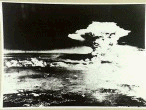
AWM 043863 | Hiroshima, Japan, 6 August 1945: The mushroom cloud rising after the dropping of the first atomic bomb on Hiroshima. The bomb was dropped from an aircraft known as the Enola Gay, a B29 bomber of the United States Air Force. An estimated 60,000 people died in Hiroshima. On 9 August a second atomic bomb was dropped on the city of Nagasaki. The decision by the Japanese government to surrender was taken in the aftermath of the dropping of the atomic bombs. |

AWM 044330 | Nagasaki, Japan, August 1945: A mother and her baby in Nagasaki some days after the explosion of an atomic bomb on that city. |
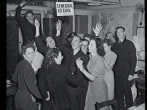
AWM UK3128 | London, England, 10 August 1945: Australians, civilian staff and members of the RAAF, at Kodak House, RAAF Overseas Headquarters celebrate the offer of Japanese surrender. This offer was made on 10 August, one day after the dropping of the world’s second atomic bomb on Nagasaki. |
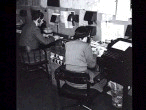
AWM 113011 | Melbourne, Victoria, 14 August 1945: Staff at the Department of Information listening post endeavouring to pick up the signal regarding the official Japanese surrender. The messages were being relayed by short wave telephone direct from Tokyo. The Japanese offer of surrender on 10 August was conditional upon the acceptance by the Allies of the prerogatives of the Emperor. The Allies replied that before they would accept any surrender the Japanese must agree that the Emperor and government be subject to the proposed Supreme Commander of the Allied Powers, Japan. The Japanese government agreed and the surrender of Japan became effective on 15 August 1945. |

AWM P00444.098 | Guam Island, Pacific Ocean, 15 August 1945: A Japanese prisoner of war of the Americans weeps as he hears the Emperor’s broadcast voice announcing Japan’s unconditional surrender to the Allies. |

AWM 019422 | Yokosuka Naval Base, Japan, 30 August 1945: Captain H. J. Buchanan, Royal Australian Navy, accepting the keys of the Yokosuka Naval Base from Commander TANNO Yuzo. Captain Buchanan led the first British Empire and Commonwealth landing party to go ashore in Japan. |
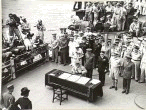
AWM 019122 | On board USS Missouri, Tokyo Bay, 2 September 1945: General Sir Thomas Blamey, preparing to sign the official Japanese surrender document on behalf of Australia. Behind General Blamey at the microphone is General Douglas MacArthur, Supreme Commander, Allied Powers, Japan. Ranged to the right of General MacArthur are three senior officers representing the Australian Army, Royal Australian Navy and Royal Australian Air Force – Lieutenant General Frank Berryman, Air Vice-Marshal William Dowling Bostock and Rear Admiral G. D. Moore. The following ships of the Royal Australian Navy were present in Tokyo Bay for the surrender ceremony: HMAS Shropshire, Hobart, Warramunga, Bataan, Nizam and Napier. |

AWM 040962 | On board USS Missouri, Tokyo Bay, 2 September 1945: Mr SHIGEMITSU Mamoru, Japanese Foreign Minister, signing the surrender document on behalf of Japan. |

AWM OG3444 | Yokohama, Japan, September 1945: Destruction caused by the American incendiary bombing of Yokohama. The photograph was taken by Wing Commander R. Laurie, Adelaide, South Australia, who was a member of the official Australian party at the signing of the Japanese surrender document on USS Missouri on 2 September 1945. From June 1944 American Bomber Command commenced operations against major Japanese cities and towns. Japan estimated her military casualties during the Pacific war at 780,000 combat troops; during a nine month period American Superfortress bombers caused an estimated 806,000 casualties in Japan itself. In one raid on Tokyo on 9/10 March 1945 by 300 American Superfortresses a quarter of the city’s buildings were burnt out 83,000 people killed and over a million made homeless. Later Prince KONOE Fumimaro, Japan’s Prime Minister up to October 1941, said that: fundamentally the thing that brought about the determination to make peace was the prolonged bombing by the B-29s. |

AWM 121298 | Yokohama, Japan, 7 September 1945: Captain John Charles Goodchild, official Australian war artist, painting in a Yokohama street. |
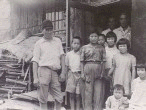
AWM 121292 | Yokohama, Japan, 8 September 1945; Photograph taken by Captain John Charles Goodchild, an official Australian war artist, of Japanese families in Yokohama. The original caption states that the building behind them was one of the few which remained standing in the city. |
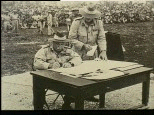
AWM OG3474 | Morotai, Halmahera Islands, Netherlands East Indies (Indonesia), 8 September 1945: General Sir Thomas Blamey, watched by a large crowd, signs the surrender document of the II Japanese Army commanded by Lieutenant General TESHIMA Fusataro. On this occasion Blamey made a statement which included the following sentences: In receiving your surrender I do not recognise you as an honourable and gallant foe but you will be treated with due but severe courtesy in all matters. I recall the treacherous attack on an Australian ally, China. I recall the treacherous attack upon the British Empire and upon the United States of America in December 1941, at a time when your authorities were making the pretence of ensuring peace between us. I recall the atrocities inflicted upon the person of Australian nationals as prisoners of war and internees, designed to reduce them by punishment and starvation to slavery. Other major surrenders of Japanese armies in the field to Australian forces took place at Cape Wom, New Guinea and aboard the aircraft carrier HMS Glory off Rabaul, New Britain. Approximately 344,000 Japanese soldiers surrendered to the Australians in Borneo and Rabaul. |
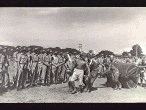
AWM 117044 | Singapore, Singapore Island, 1 September 1945: Japanese prisoners of war dragging a large roller across a parade ground. In the background Australians of the 1st Australian Paratroop Battalion rehearse for the Japanese surrender ceremony at Singapore scheduled 12 September. |
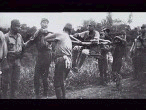
AWM 128800 | Kiarivu, New Guinea, 12 September 1945: General ADACHI Hatazo, Commanding Officer, Japanese 18th Army, being carried by Japanese soldiers, and accompanied by staff officers and orderlies, into the headquarters, 17th Brigade, 6th Division, 2nd AIF. ADACHI, who had been declared medically unfit to walk long distances, had come to surrender the 18th Army. Next morning he was flown from Yamil to Wewak where he formally surrendered at Cape Wom airstrip to Major General Horace Robertson General Officer Commanding, 6th Division. |
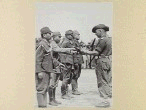
AWM 096234 | Cape Wom airstrip, Wewak, New Guinea, 13 September 1945: Japanese officers of the 18th Japanese Army handing over their swords to an Australian officer of the 6th Division, 2nd AIF. On this day at Cape Wom General ADACHI Hatazo, commanding officer, Japanese 18th Army, formally surrendered to Major General Horace Robertson, General Officer Commanding, 6th Division. In October 1944 the 18th Army numbered between 35,000 and 40,000 men. By 13 September 1945 there were 13,500 left. Approximately 9,000 were killed during the 6th Division’s campaign against them between December 1944 and August 1945, and the rest died of disease and malnutrition. All told during the Pacific war the Japanese landed approximately 300,000 troops in Papua New Guinea and the Solomon Islands along with 20,000 civilian workers. Only 127,000 were alive at war’s end in August 1945. |
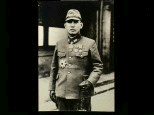
AWM P01881.001 | Portrait of Major General MANO Goro, taken in Shokoa Province, China. c.1942: The original caption to this photograph states that Major General MANO, who served in the Philippines, Guadalcanal and New Guinea, surrendered at Wewak, New Guinea, in October 1946, over a year after the official end of the Pacific war and the surrender of Japan. He died in 1957 and the samuri sword he is wearing, manufactured c.1450, is in the collection of the Australian War Memorial. |
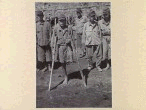
AWM 097019 | Bougainville, Solomon Islands, 18 September 1945: A crippled Japanese soldier on Numa Numa Beach awaiting evacuation, along with other sick and wounded Japanese, to Torokina. The photograph was taken shortly after an Australian party from 2 Corps Headquarters had arrived to negotiate terms of surrender with Major General KIJIMA for Japanese forces in the area. In late 1944 the Australians estimated the Japanese garrison of Bougainville at around 18,000. At the surrender it was found that in November 1944 there had been 42,000 Japanese on the island. At the surrender in September 1945, 23,571 were left; 8,500 died in battle and 9,800 of disease and malnutrition. Five hundred and sixteen Australians died during the campaign against the Japanese on Bougainville between November 1944 and August 1945. |

AWM 096778 | Buka Island, Bougainville, Solomon Islands, 19 September 1945: Japanese naval troops listing and placing name tags on the swords of Japanese officers in preparation for their collection by a surrender party from 2 Australian Corps. |
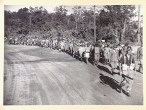
AWM 096953 | Bougainville, Solomon Islands, 23 September 1945: Japanese naval troops escorted by soldiers of the 27th Australian Infantry Battalion during a march to a concentration compound south of the Torokina River. |
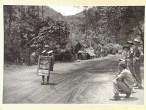
AWM 097447 | Rabaul, New Britain, 3 October 1945: A Japanese soldier with an “Australian Victory Loan” sandwich-board walking around the Headquarters of 11 Division. The original caption states that he is helping to promote loan contributions from the troops. |
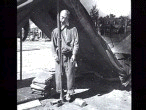
AWM 118693 | Labaun Island, Borneo, 24 October 1945: The body of Colonel AIKYO, former commander of the Japanese garrison at Miri on the Borneo coast, who committed suicide during the night of 23 October 1945 at Labuan POW compound. Colonel AIKYO hanged himself with a piece of wire used to fasten his tent flap and a pile of folded blankets to give his body extra weight. His body was cut down earlier but restored as near as possible to its original position for this photograph. |

AWM 119938 | 1st POW camp, Labuan Island, Borneo, 11 October 1945: Lieutenant E. A. Douglas Watson, official Australian war artist, Military History Section, drawing Major General TSUCHIDA, Quartermaster, 37th Japanese Army. |
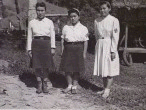
AWM 122579 | Samarinda, Balikpapan area, Borneo, 24 November 1945: Three Japanese armed forces civilian nurses. One of a series of photographs taken by Australians showing the types of uniforms of the Japanese armed forces who surrendered to them in Borneo |
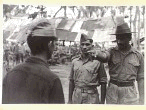
AWM 098781 | Rabaul, New Britain, 15 November 1945: An Indian soldier, who worked for the Japanese as a prisoner of war, identifying a Japanese soldier. This action took place during a special parade of Japanese soldiers to uncover suspected war criminals arranged by the War Crimes Commission, Headquarters, 11th Australian Division. |
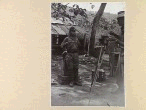
AWM 098774 | Rabaul, New Britain, 15 November 1945: Sergeant R Rice, Official Photographer, Military History Section, Headquarters, 11th Australian Division, taking photographs of suspected Japanese war criminals. These photographs were taken after the Japanese had been identified by former Indian Army prisoner of war who had been forced to work for the Japanese in the area. |

AWM 122733 | Labaun Island, Borneo, 27 November 1945: Two Japanese prisoners of war, wearing protective equipment, giving a demonstration Ju Ken Jitsu (Kendo) for Australians troops. |
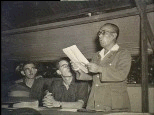
AWM OG3715 | Morotai, Halmahera Islands, Netherlands East Indies (Indonesia), 12 January 1946: This photograph was taken during the Australian war crimes trial of Rear Admiral HAMANAKA Kyoho. HAMANAKA was charged and found guilty of having ordered the execution of a Royal Australian Air Force airman and a member of the Royal Australian Navy near Menado, north Celebes Islands, on 19 June 1945. After hearing his sentence and being asked if he had anything to say in mitigation, Rear Admiral HAMANAKA delivered an impassioned speech during which he concluded that: The sentence would appear to be a conspiracy against me and against Japan. |
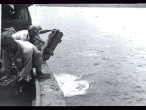
AWM 099844 | Rabaul, New Britain, 19 February 1946: Japanese soldiers under Australian supervision dump ammunition and explosives into the sea. |

AWM NWA1047 | Emery Point, Darwin, 1 March 1946: Captain W. Cole, Oakleigh, Victoria, defending counsel for Japanese prisoners of war accused of war crimes and appearing before an Australian war crimes trial at Darwin. This was the only war crimes trial to be held on Australian soil. |
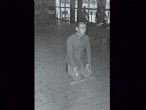
AWM 125966 | Emery Point, Darwin, Northern Territory, 4 March 1946: Captain SAIKI, Japanese Imperial Army, demonstrates to an Australian war crimes trial the technique called the “log” torture used to extract information from prisoners. |

AWM P01420.001 | Melbourne, Victoria, c.1945; Studio portrait of Sergeant Doris Mary Heath, Australian Women’s Army Service. Sergeant Heath was an interpreter at Japanese war crimes trials held at Rabaul, New Britain, and in Tokyo, Japan. |
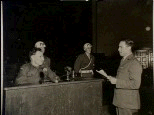
AWM P02289.002 | Tokyo, Japan, 19 December 1946: Warrant Officer William Hector Sticpewich, Australian Army Service Corps, 8th Australian Division, being questioned by Lieutenant Colonel T. F. E. Murnane, an American prosecutor during the Tokyo war crimes trials. Warrant Officer Sticpewich was captured by the Japanese at Singapore on 15 February 1942 and subsequently imprisoned in the Sandakan POW camp, north Borneo. He was one of only six soldiers, all Australians, to survive the war out of an estimated 2,500 Australian and British POWs who were alive in the Sandakan camp at the beginning of 1945. During the Tokyo war crimes trials he supplied eyewitness accounts of the mistreatment and torture inflicted by Japanese soldiers on the POWs at Sandakan camp, during three forced POW marches to the settlement of Ranau 260 kilometres inland, and at Ranau itself. His testimony helped secure the conviction of a number of former Japanese Sandakan camp guards. |

AWM P02310.004 | Changi Prison, Singapore Island, 1946: A hangman placing a noose over the hooded head of a convicted Japanese war criminal immediately prior to his execution. As a result of the judgements passed at Australian War crimes trials 148 Japanese was criminals were executed either by hanging or firing squad. |

AWM 306748 | Manus Island, Admiralty Islands, New Guinea, c.1948: Members of the Japanese War Criminals Construction Unit shovelling and digging as they prepare the foundations of a house at the Royal Australian Navy’s War Criminal Compound at the shore base HMAS Tarangau. A member of the Royal Australian Navy and the Royal Papuan Constabulary can be seen supervising the prisoners. Of the 644 Japanese war criminals convicted at war crimes trials, 496 were imprisoned by Australia. |

AWM 131649 | Ujina, Japan, 27 June 1946: An Australian soldier of the British Commonwealth Occupation Force (BCOF), Japan, watching as Japanese repatriated soldiers from Singapore march through the gates of the Ujina Repatriation Depot. Australia was responsible for the repatriation of Japanese service personnel and civilians in all those areas in which Australian forces had accepted the surrender of Japanese armies in the field. According to the original caption to this photograph the Japanese writing on the two gate pillars translates as: Lets do our best (left pillar), and Ujina Repatriation Centre (right pillar). The translation should read: Lets do things firmly, cordially; don’t lose heart; keep up your spirits (left pillar) and Repatriates, thank you all for suffering such hardship [for us]; you have all suffered such hardship (right pillar). The small text at the bottom of each pillar’s main inscription reads Ujina Repatriation Centre. |
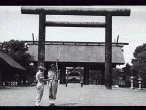
AWM 131485 | Tokyo, Japan, 2 September 1946: An Australian guard from the British Commonwealth Occupation Force (BCOF), Japan, outside the Yasukuni Shrine. This shrine was dedicated to the souls of all Japanese who had died for the Emperor in conflicts, in Japan and abroad, since the middle of the nineteenth century. |
|